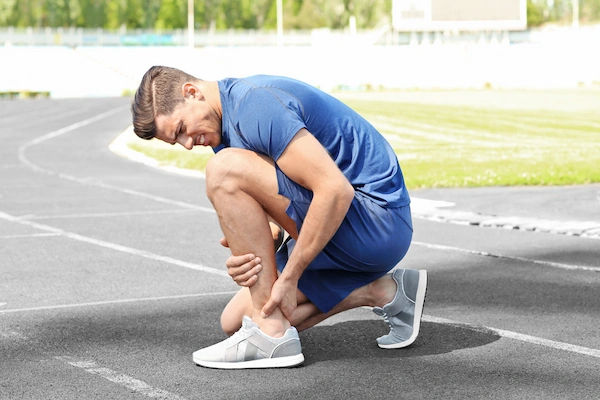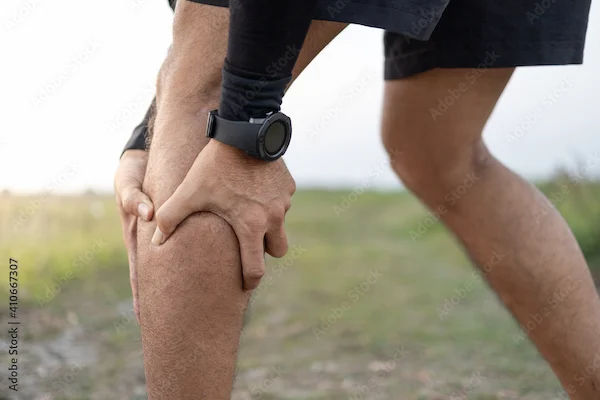Charley Horse: Causes, Relief, and How to Prevent It
Discover the causes of charley horses, learn effective techniques for immediate relief, and explore proven strategies to prevent leg cramps.


Introduction
That sudden, sharp, and utterly debilitating cramp in your leg—known universally as a charley horse—can strike without warning, jolting you awake from a deep sleep or halting your mid-stride. While usually short-lived, the intense pain of a muscle spasm can be a memorable and unpleasant experience. But what exactly triggers these involuntary muscle contractions? More importantly, how can you stop the pain when it happens and prevent it from recurring? This article delves deep into the world of charley horses, moving beyond basic advice to explore the root causes, from common nutrient deficiencies to underlying health conditions. We'll provide actionable strategies for immediate relief and long-term prevention, empowering you to take control of your muscle health and finally put those painful cramps to rest.
What Exactly Is a Charley Horse?
A charley horse is the common term for a sudden, involuntary, and often painful contraction or spasm of a muscle, typically occurring in the legs. These spasms can last anywhere from a few seconds to several minutes, and the muscle may feel tender and sore for hours afterward. While they most frequently affect the calf muscle, they can also occur in the thighs (quadriceps or hamstrings) and feet.
The Science Behind the Spasm
Muscles move through a complex process of contraction and relaxation, controlled by nerve signals and fueled by electrolytes. A charley horse occurs when this process is disrupted, causing the muscle fibers to contract forcefully but fail to receive the signal to relax. This results in a hard, knotted sensation and significant pain. Think of it as a miscommunication between your nerves and muscles, leading to a sustained "on" signal.
Consult a Specialist for the best advice
Top Causes: Why Your Muscle Suddenly Seizes Up
Understanding the triggers is the first step toward effective prevention.
Dehydration and Electrolyte Imbalance
This is one of the most common culprits, especially for athletes or those in hot climates. Electrolytes like sodium, potassium, and magnesium are crucial for transmitting nerve signals. When you're dehydrated, the balance of these fluids and minerals is disturbed, increasing the likelihood of misfires and spasms.
Overexertion and Muscle Fatigue
Pushing your muscles too hard during exercise, especially without proper conditioning, can lead to fatigue. Tired muscles are more susceptible to cramping as they have a harder time regulating contraction and relaxation cycles. This is common in both athletes and weekend warriors who may overdo it.
The Role of Essential Minerals: Potassium, Magnesium, and Calcium
Deficiencies in key minerals are a primary cause of frequent nocturnal leg cramps.
- Potassium: Helps maintain fluid balance and muscle function. Low levels (hypokalemia) directly contribute to weakness and cramping.
- Magnesium: Plays a key role in muscle relaxation. A deficiency means your muscles may struggle to "let go" after contracting.
- Calcium: Acts as a messenger for muscle contractions. An imbalance can disrupt the process.
Poor Blood Circulation and Nerve Compression
Conditions like peripheral artery disease (PAD) can narrow arteries, reducing blood flow to the legs and causing cramping, often during activity. Similarly, nerve compression, such as from a herniated disc or spinal stenosis (lumbar spinal stenosis), can irritate the nerves that serve your legs, leading to cramp-like pain.
Underlying Medical Conditions to Be Aware Of
Frequent, severe charley horses can sometimes be a sign of an underlying issue, including:
- Diabetes (which can cause nerve damage and electrolyte imbalances)
- Thyroid disorders
- Kidney disease (impairing fluid and mineral balance)
- Liver cirrhosis
- Restless legs syndrome (RLS), though distinct, is sometimes confused with cramping.
Medications That Can Trigger Muscle Cramps
Certain drugs are known to cause cramps as a side effect. These include some diuretics (water pills), statins (for cholesterol), medications for high blood pressure, and asthma medications like albuterol.
The Pregnancy Connection
Charley horses during pregnancy are very common, particularly in the second and third trimesters. This is likely due to a combination of factors: increased weight putting strain on muscles, changes in circulation, and potential electrolyte imbalances.
Immediate Relief: How to Stop a Charley Horse in Its Tracks
When a cramp strikes, quick action can shorten its duration and alleviate pain.
Gentle Stretching Techniques
- For a Calf Cramp: Sit down and straighten your leg. Gently pull the top of your foot on the affected side toward your shin, keeping your knee straight. You should feel a stretch in the back of your calf.
- For a Thigh Cramp (Quad): Stand up (hold onto a chair for balance) and pull your foot toward your glute on the same side.
- For a Hamstring Cramp: Sit with your leg extended and gently lean forward until you feel a stretch in the back of your thigh.
Massage and Heat Therapy
Once the initial spasm subsides, gently massage the knotted muscle to promote blood flow and relaxation. Applying a warm towel or heating pad can also help loosen the tense muscle fibers.
When to Use Cold Compresses
If the muscle is sore and tender after the cramp has passed, a cold pack wrapped in a towel can help reduce inflammation and numb the pain.
Effective Prevention Strategies: Keeping Cramps at Bay
Prevention is always better than cure. A multi-faceted approach is most effective.
Hydration Guidelines: Are You Drinking Enough?
Don't wait until you're thirsty. Drink water consistently throughout the day. If you exercise, ensure you hydrate before, during, and after your activity. For intense workouts, consider an electrolyte-replenishing drink.
Optimising Your Diet for Muscle Health
Incorporate foods rich in potassium (bananas, sweet potatoes, spinach, yogurt), magnesium (nuts, seeds, leafy greens, whole grains), and calcium (dairy, fortified plant milks, broccoli). If you suspect a deficiency, a blood test can confirm it. Apollo24|7 offers a convenient home collection for tests like vitamin D or electrolyte panels to check your levels without a clinic visit.
The Importance of Proper Stretching (Pre and Post-Exercise)
Incorporate dynamic stretches before a workout to warm up the muscles and static stretches afterward to improve flexibility and reduce tension. Regularly stretching your calves and hamstrings before bed can be particularly effective for preventing nighttime leg cramps.
Choosing the Right Footwear
Avoid shoes with poor arch support or high heels for extended periods, as they can strain the muscles in your feet and calves.
Adjusting Your Sleep Position
Try to sleep with your toes pointed slightly upward. You can prop up your feet with a pillow or let the covers hang loose at the foot of the bed to keep your feet in a neutral position.
When to See a Doctor: Recognising Red Flags
While most charley horses are harmless, you should consult a doctor if you experience:
- Cramps that are severe and frequent.
- Cramps that don't improve with self-care.
- Swelling, redness, or skin changes in the affected leg.
- Muscle weakness accompanying the cramps.
- Cramps that started after you began taking a new medication.
If your condition does not improve after trying these methods, book a physical visit to a doctor with Apollo24|7 to rule out any underlying conditions that may require specific treatment.
Conclusion: Taking Proactive Control
Charley horses, while painful, are often a message from your body about its needs—be it more water, better nutrients, or simply a good stretch. By understanding the diverse causes, from electrolyte imbalance to poor circulation, you can move beyond temporary fixes and implement lasting lifestyle changes. Prioritise hydration, nourish your body with mineral-rich foods, and incorporate regular stretching into your routine. Pay attention to when the cramps occur; this clue can be the key to stopping them for good. If self-management isn't enough, don't hesitate to seek professional medical advice to ensure there isn't a more serious issue at play. Taking a proactive approach empowers you to relieve the immediate pain and, more importantly, prevent it from returning.
Consult a Specialist for the best advice
Consult a Specialist for the best advice

Dr. Rajib Ghose
General Physician/ Internal Medicine Specialist
25 Years • MBBS
East Midnapore
VIVEKANANDA SEBA SADAN, East Midnapore

Dr. Abhishek Ranjan
General Practitioner
4 Years • MBBS
Kolkata
VDC Clinic, Kolkata

Dr. Tapabrata Ray
General Physician/ Internal Medicine Specialist
4 Years • MBBS,DGM,CPMeC,ACMDC
Kolkata
MCR SUPER SPECIALITY POLY CLINIC & PATHOLOGY, Kolkata

Dr. Sougata Kumar
General Practitioner
8 Years • MBBS
East Midnapore
VIVEKANANDA SEBA SADAN, East Midnapore

Dr. Soumen Paul
General Physician/ Internal Medicine Specialist
24 Years • MBBS
Kolkata
MCR SUPER SPECIALITY POLY CLINIC & PATHOLOGY, Kolkata
(25+ Patients)
Consult a Specialist for the best advice

Dr. Rajib Ghose
General Physician/ Internal Medicine Specialist
25 Years • MBBS
East Midnapore
VIVEKANANDA SEBA SADAN, East Midnapore

Dr. Abhishek Ranjan
General Practitioner
4 Years • MBBS
Kolkata
VDC Clinic, Kolkata

Dr. Tapabrata Ray
General Physician/ Internal Medicine Specialist
4 Years • MBBS,DGM,CPMeC,ACMDC
Kolkata
MCR SUPER SPECIALITY POLY CLINIC & PATHOLOGY, Kolkata

Dr. Sougata Kumar
General Practitioner
8 Years • MBBS
East Midnapore
VIVEKANANDA SEBA SADAN, East Midnapore

Dr. Soumen Paul
General Physician/ Internal Medicine Specialist
24 Years • MBBS
Kolkata
MCR SUPER SPECIALITY POLY CLINIC & PATHOLOGY, Kolkata
(25+ Patients)
More articles from Muscle cramp
Frequently Asked Questions
What is the fastest way to get rid of a charley horse?
The fastest way is to stop the activity and gently but firmly stretch the affected muscle. For a calf cramp, straighten your leg and pull your toes toward your shin. Hold the stretch until the cramp subsides.
Can dehydration cause charley horses even if I don't feel thirsty?
Absolutely. Thirst is a sign you're already becoming dehydrated. By the time you feel thirsty, your body's fluid and electrolyte imbalance may already be significant enough to predispose you to muscle cramps.
Are there any specific exercises to prevent nighttime leg cramps?
Yes. Simple calf stretches are highly effective. Stand arm's length from a wall, place your hands on it, and step back with one leg, keeping it straight and heel on the floor. Bend your front knee until you feel a stretch in the calf of the back leg. Hold for 30 seconds and repeat 2-3 times per leg before bed.
Is pickle juice an effective home remedy for leg cramps?
Some studies suggest it might be. The theory is that the vinegar or salt in the juice may trigger a reflex in the mouth that signals the nervous system to stop the muscle spasm. While not harmful in small amounts, it's not a substitute for addressing underlying causes like hydration and nutrition.
When should I be concerned about a charley horse?
You should be concerned and seek medical advice if the cramps are extremely painful and frequent, cause significant muscle weakness, are associated with swelling or redness, or do not respond to any self-care measures.




